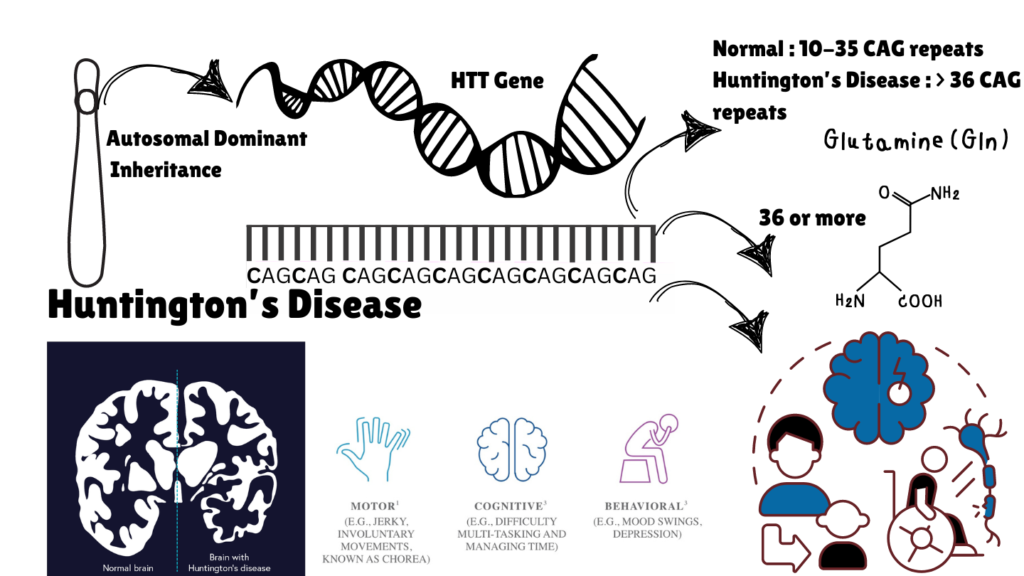Huntington’s disease (HD) is a rare, inherited neurodegenerative disorder affecting the central nervous system. Characterized by involuntary movements, behavioral disturbances, and dementia, HD typically manifests between ages 30 and 50, though juvenile cases also occur. Symptoms include chorea, dystonia, cognitive decline, psychiatric issues, and difficulties with speech and swallowing. The disease leads to complete dependency and eventually death, often from pneumonia or suicide. HD is caused by a mutation in the huntingtin (HTT) gene on chromosome 4(4p16.3), involving an elongated CAG repeat. In affected individuals, this gene has errors in its nucleotide sequence, leading to abnormally long repeats of cytosine, adenine, and guanine (CAG trinucleotide repeat expansion). The number of these expanded repeats can influence the age at which symptoms appear. The disease’s characteristic symptoms and physical features arise from the degeneration of neurons in specific brain regions, such as the basal ganglia and cerebral cortex. The length of this repeat correlates with the disease’s onset and severity. Diagnosis is based on clinical symptoms and genetic testing. International Huntington’s Disease Awareness Day is celebrated the 15th of May.
Clinical Description
| Classification Level | Disorder |
| Prevalence | 1-9 / 100 000 |
| Age of Onset | Adolescent, Adult, Childhood, Elderly |
| Inheritance | Autosomal dominant |
Symptoms typically begin between ages 30-50 and include Chorea (involuntary jerky movements) that gradually affects all muscles, rare tics like Tourette syndrome. Sporadic cerebellar signs (hypo- and hypermetria). Dystonia (e.g., torticollis) may be an initial motor sign, sleep and circadian rhythm disturbances autonomic nervous system dysfunction, Dysarthria (difficulty in articulating words), Dysphagia (difficulty swallowing) leading to choking, Hypokinesia and rigidity progressing to bradykinesia and severe akinesia. Severe impairment of psychomotor processes. Progressive cognitive deterioration as well as include low self-esteem, guilt, anxiety, and apathy (33%-76% of patients).

Image I: Huntington’s Disease Progression and Symptoms; Image Source: Malini Gupta
Diagnosis and Current Treatment
There is no cure, but treatments can manage symptoms. Medications can address anxiety, depression, and movement issues. Therapy can help with strength, safety, communication, and nutrition. Social and community support is crucial for both patients and caregivers. HD’s symptoms worsen over 10 to 25 years, affecting personality, mood, cognition, and motor skills. Patients eventually need full-time care and face significant weight loss, difficulty with daily activities, and a high risk of complications.
Therapies for HD are categorized by the symptoms they address, such as medications for chorea, antipsychotics, antidepressants, mood stabilizers, and non-drug therapies. New treatments are being developed that target the root cause of HD by reducing levels of mutant huntingtin protein (mHTT). Notably, antisense oligonucleotide (ASO) therapies, which bind to pre-RNA or mRNA to alter protein expression, are receiving significant attention. Other therapies in clinical development include RNA interference (RNAi) therapies, RNA-targeting small molecules, stem cell therapies, antibody therapies, non-RNA-targeting small molecules, and treatments targeting neuroinflammation. Zinc-Finger Protein (ZFP) therapies, transcription activator-like effector nuclease (TALEN) therapies, and CRISPR/CRISPR-associated system (Cas) therapies are some of the potential candidate therapies in pre-clinical development.
For more on the latest curatives for this disease, stay tuned for H for Huntington’s Disease part II. Meanwhile, click here for more available resources and support groups for Huntington’s Disease.
Dr. Malini Gupta, Ph.D.
Sources
- https://rarediseases.org/rare-diseases/huntingtons-disease/
- https://www.orpha.net/en/disease/detail/399
- https://www.ncbi.nlm.nih.gov/pmc/articles/PMC9125092/
- https://www.hda.org.uk/get-involved/campaiging/huntingtons-disease-awareness-month-2023/
- Figure inspired from: https://www.youtube.com/watch?v=ohAh00iQFLY
- https://www.science.org.au/curious/people-medicine/huntingtons-disease
Disclaimer
The editors take care to share authentic information. In case of any discrepancies please write to newsletter@medness.org.
The sponsors do not have any influence on the nature or kind of the news/analysis reported in MedNess. The views and opinions expressed in this article are those of the authors and do not necessarily reflect the official policy or position of MedNess. Examples of analysis performed within this article are only examples. They should not be utilized in real-world analytic products as they are based only on very limited and dated open-source information. Assumptions made within the analysis are not reflective of the position of anyone volunteering or working for MedNess. This blog is strictly for news and information. It does not provide medical advice, diagnosis or treatment nor investment suggestions. This content is not intended to be a substitute for professional medical advice, diagnosis, or treatment. Always seek the advice of your physician or another qualified health provider with any questions you may have regarding a medical condition. Never disregard professional medical advice or delay in seeking it because of something you have read on this website.
MedNess is a part of STEMPeers® which is a 501(c)(3) organization registered in PA as PhD Career Support Group. The organization helps create a growing network of STEM scientists that is involved in peer-to-peer mentoring and support.



